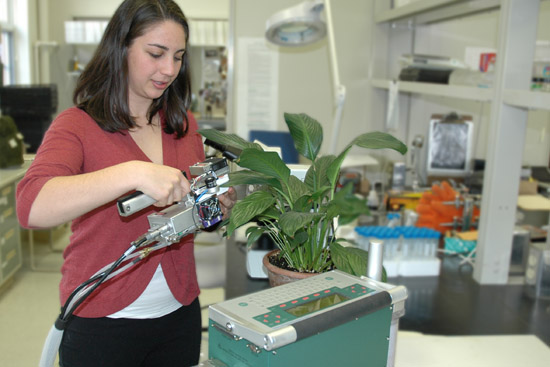Kresge Foundation Challenge Grant Supports New Science Equipment
 |
| Lauren Nichols, a BA/MA biology student, demonstrates how the new LICOR Li-6400 measures the rate of carbon fixation via photosynthesis in living plants. |
| Posted 01/15/08 |
| A challenge grant from The Kresge Foundation is supporting much-needed equipment for the sciences at Wesleyan.
With a challenge grant from The Kresge Foundation, Wesleyan has already acquired a photosynthesis system, microplate reader, spectrometers and a dye laser. With $500,000 raised from donors, the foundation provided a grant of $250,000 for a total of $750,000 used towards the equipment purchase. And this month, Wesleyan will receive an additional $250,000 from the foundation to support future equipment purchases and equipment repair. Wesleyan raised $1 million over the past 18 months to support this endowment. This equipment provides opportunities for our faculty and students to do research at the highest levels, explains David Bodznick, dean of Natural Sciences and Mathematics, professor of biology and neuroscience and behavior. It expands our capabilities and allows our scientific inquiry to keep pace with the intellectual capacity of our researchers. Several departments received equipment. Sonia Sultan, professor of biology, uses a new photosynthesis system; Philip Bolton, professor of chemistry and chair of the Chemistry Department, is using a microplate reader; Rex Pratt, the Beach Professor of Chemistry, is using a LC-Mass Spectrometer; and the Chemistry Department is using a Gel Permeation Chromatograph. Tim Ku, assistant professor of earth and environmental sciences, is using his department’s new ICP-Mass Spectrometer; Bill Herbst, the John Monroe Van Vleck professor of Astronomy and chair of the Astronomy Department, is using a new CCD camera; and Brian Stewart, associate professor of physics, is using the Physics Department’s new YAG/dye laser. “With a special light filter, it even lets us take stunning photos of objects as bright as the moon (see image at left),” Konon says. Sultans plant evolutionary ecology lab frequently uses the new LICOR Li-6400 photosynthesis system, which is a state-of-the-art gas analyzer that measures physiological rates on the leaves of living plants under controlled amounts of light from a built-in light source. These measurements provide key insights into how efficiently plants function in specific environmental conditions. Her students have used the system to study an introduced species called Polygonum cespitosum that has become invasive in New England. Their LICOR data showed that study populations of this species are evolving very rapidly to photosynthesize at higher rates in sunny habitats, where the species has begun to spread. Sultan presented the findings at a joint U.S.-Japan workshop on plant response to global environmental change in October 2007. It’s great that students in my lab have the chance to study plant function using the LICOR system, considered the best available instrument for photosynthesis work,” Sultan says. Pratt says the departments new electrospray mass spectrometer is an important addition to the instrumentation available to Wesleyan chemists and biochemists. With this instrument, we are now able to obtain the mass spectra and molecular weights of many polar and ionic molecules, Pratt says. Since most biomolecules are of this type, the instrument is essential to modern biological chemistry. Bolton’s new microplate reader has become equally essential for research projects involving the interactions of DNA molecules with proteins and in projects aimed at finding drug-like molecules that bind to specific sites in the genome. Before acquiring the plate reader, Bolton and his students had to prepare large samples and measure each one separately, which is both time consuming and uses lots of material. With the plate reader, the lab can prepare as many as 256 very small samples on a microplate and the reader can determine the fluorescence of all of the samples in the same, or less time than measuring one large sample by the previous method. This allows us to carry out much more extensive measurements, Bolton explains. In addition, many plates can be prepared at the same time. Since the students can now acquire much larger data sets they can also use more sophisticated statistical methods to analyze their data. The Kresge Foundation of Troy, Mich. is one of the foremost supporters of independent higher education and nonprofit organizations. The foundation works to address societys pressing issues in six fields of interest including health, the environment, arts and culture, education, human services and community development. |
| By Olivia Drake, The Wesleyan Connection editor |


 Herbst’s graduate student Jenny Konon says the department’s new camera makes astronomical observing more efficient. The camera enables users to take photographs of faint, distant objects with super-short exposures.
Herbst’s graduate student Jenny Konon says the department’s new camera makes astronomical observing more efficient. The camera enables users to take photographs of faint, distant objects with super-short exposures.